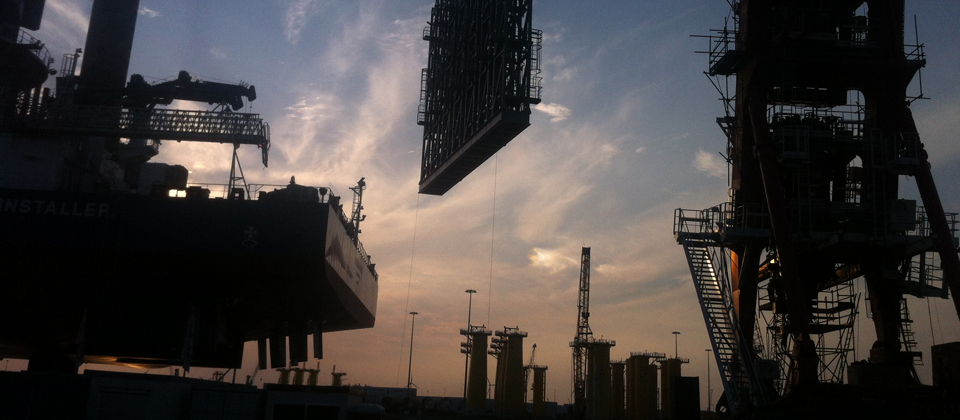
By Glen Andresen, Senior Manager, Project Engineering
A2SEA has done plenty of mobilisations over the years. But never one quite like the recent makeover of SEA INSTALLER for West of Duddon Sands. It was the biggest mobilisation we have ever attempted – both in time, in effort and in the sheer number of people involved.
SEA INSTALLER needed to be refitted to handle the installation of 108 turbines at the wind farm, using Belfast harbour as her loading point. Prior to this task, the vessel had installed 30 monopile foundations and transition pieces in readiness for the turbines – work that Pacific Orca would continue while SEA INSTALLER worked through the winter to erect the turbines.
Plenty to do
The mobilisation project started during the summer of 2012 with the design and planning phases. Mobilisation would first begin in August 2013, but preparation is crucial in this game and we are always ready to do whatever is necessary to ensure everything runs as smoothly as possible.
The all-important aspect of safety was a key part of the process from the early planning stage to vessel departure. As is the case with all other offshore wind transport and installation tasks, there are quite specific safety aspects associated with mobilisation, and these demand careful attention. Safety assessments and planning were conducted together with the yard and client on daily basis.
The three major components required for sea fastening (tower fastening, nacelle fastening and blade rack) all needed to be installed. We also had to move one of the existing cranes to the deckhouse – and install a very large new auxiliary crane on the aft deck of the vessel as well as a new aft deck utility platform. A boat landing was required on the side of the vessel which, in turn, required reinforcing SEA INSTALLER’s side. Finally, the liferaft davit on the port side needed to be removed along with its associated structures. Many of the modifications demanded classification society certification, including class approval for the crane reinforcements.
All hands on deck
The project was to begin with a demobilisation phase. We had worked hard to determine a start date where everyone – our own team, the Dutch fabricator and all of the sub-contractors – could get things underway. Finally, we settled on Thursday, August 8. That, you might say, was the easy part.
If there’s one particular challenge that stands out from the many issues, that needed to be dealt with it’s the logistics of it all. Just finding a suitable port for the job was a challenge in itself. Together with our client, we discussed using Belfast, Esbjerg and others before deciding upon the port of Vlissingen in the Netherlands.
Complicating things was the fact that most of the sea fastening, including the fastening for the tower, was produced in Denmark, while the blade rack was built at two different locations in the Netherlands. So not only did we have to transport the tower formation to Vlissingen (for which we used SEA POWER), but there was also a local Dutch inland waterway transport to arrange before the arrival of SEA INSTALLER. Even if you’re new to this industry, you’ll probably know that each transport is a complex mini-project in itself!
A mobilisation of this size and complexity is a big puzzle that requires plenty of experience, expertise and foresight to fit together. But beyond minor challenges with the tower formation, where there was more welding to be done than expected, there were few significant delays. Four brilliant weeks of weather, followed by just one not-so-brilliant week, helped speed the project along and made working life more pleasant, too.
With the project completed, SEA INSTALLER was able to leave the yard on 16 September 2013, bound for Belfast and well-equipped for her new task.
Preparation is key
Getting it all to happen on time and on budget is mainly due to having everything lined up well ahead of time and to having the right manpower available, especially if something unforeseen should pop up. Another key success factor is the ability of the land-based project department and the vessel superintendent to work together. Last, but by no means least, is achieving the same high level of communication and understanding in dialogue with the client.
KEY FIGURES
Number of work permits: 500+
Number of large and small lifts: 1200+
Welders and fitters: 2 shifts of 30 per shift
Peak manpower: approximately 120
Total weight of installed sea fastening and components: approximately 650 t
Heaviest sea fastening component lifted/installed: 110 t (root end blade rack)
About West of Duddon Sands
West of Duddon Sands Offshore Wind Farm is located in the East Irish Sea approximately 14 km from the nearest coast on Walney Island, Cumbria. It is close to the operational wind farms Barrow, Walney and Ormonde. The new wind farm will comprise 108 Siemens 3.6MW wind turbines with a total installed capacity of 389MW and ensure clean renewable energy for more than 300,000 UK households.

